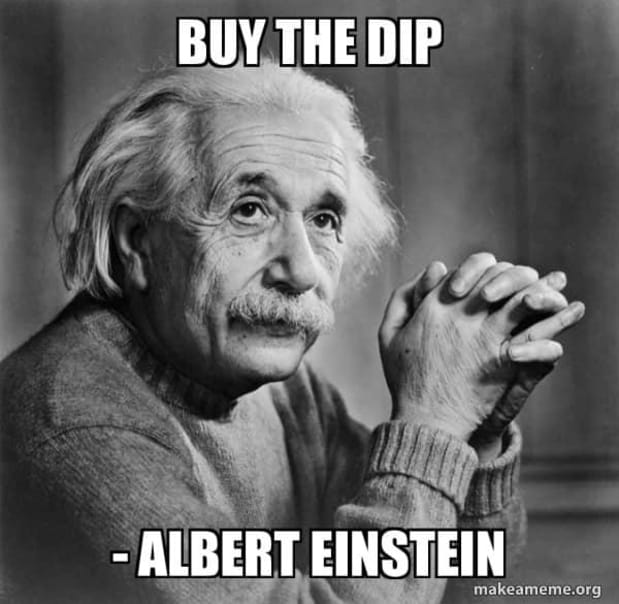The bitcoin price is often criticized as being too volatile, but as Einstein theorized, it’s all in how you look at it.
This is an opinion editorial by Tim Niemeyer, the co-host of the Lincolnland Bitcoin Meetup.
Is bitcoin volatile? How does one determine volatility? How can those with diamond hands so decisively say “no,” while those stuck in the fiat mindset so emphatically say “yes”? Which one is correct? Is it just that both sides have to agree to disagree, or can both of these seeming contradictions simultaneously be true?
To truly answer these questions, we should first analyze Albert Einstein’s special theory of relativity…
The Special Theory Of Relativity
In Einstein’s attempt to better understand how the elapsed time of two clocks moved differently, we need to look at one of his thought experiments: Imagine two individual observers, one sitting as a passenger on a train and the other onlooking from a nearby platform. The train passenger sees two bolts of lightning strike each end of the train, the first bolt from the front of the train, and the second bolt from the rear. Meanwhile, the onlooker on the nearby platform sees the two bolts strike both the front and the rear of the train at the same time. The train passenger claims that the front strike happened before the rear strike, while the onlooker claims that the strikes happened simultaneously.
Whose perception is accurate? Can both of them be? Einstein believed that both interpretations are valid because they each have their own frame of reference.
This phenomenon led to Einstein’s theory of special relativity: different reference frames necessitate different perceptions on the simultaneity of events. Said more simply, having a different reference point changes one’s perception. Granted, this is a gross oversimplification and a narrow view of a much broader concept, but this limited scope will suffice for how it relates to the disparity in perceptions regarding bitcoin’s volatility.
Bitcoin Is Not Volatile
In this analogy, let’s consider Bitcoiners as the passengers on the train. Due to the nature of the technology, we’re traveling at a consistent speed set by math and code. Inside this protocol, we see that one bitcoin equals one bitcoin. We can verify its scarcity with a supply hard cap of 21 million. We understand how the lack of need for trusted third parties or central authorities ensures a trustless and permissionless peer-to-peer system. We realize that a whale has no more clout over the control of the ledger than a shrimp. We know that every two weeks, the difficulty adjustment will continue to produce blocks at an estimated once every ten minutes; we grok the term “tick tock, next block.”
None of this speaks to volatility; just the opposite, in fact. All of this speaks to consistency; the consistency of the network. It speaks to our grounded perception from within a stable and secure system of value transfer over space and time. We passengers inside the train that is Bitcoin are better able to make economic decisions based on sound systemic fundamentals. This is one of the main reasons that Bitcoiners are able to have and maintain a low time preference; we’re not as susceptible to the distortions created by less-volatile systems, which leads to erratic economic behavior. Said differently, the predictability of the protocol perpetuates low time preference.
Bitcoin Is Volatile
From an outside onlooker’s perspective, it’s clear that bitcoin is volatile. Their main frame of reference is not the network, but simply the asset (specifically, the BTC/USD exchange rate). When the supply of the dollar fluctuates wildly, when the cost of capital is consistently manipulated — not to mention with the competing, equally-flawed currencies attempting to claw their way out of hyperinflation — the onlooker’s perception is distorted.
This is a real-world application of Wittgenstein’s Ruler, a concept which states that, “Unless you have confidence in the ruler’s reliability, if you use a ruler to measure a table you may also be using the table to measure the ruler.”
Fiat onlookers’ view of bitcoin the asset are obfuscated by their frame of reference, which is to say, an unnecessarily convoluted one.
What’s worse is that, because of this perceived volatility, onlookers are disincentivized to take a deeper look into Bitcoin the network. They find comfort in the known. They’re unwilling to do the work to understand why their arbitrarily-chosen system is flawed. As Jeff Booth points out, “Perhaps the biggest impediment for people understanding Bitcoin is bringing their baggage from how the monetary system works today and in the past, versus how it will work in the future.”
All of the misinformation inside the fiat system pushes its constituents away from connecting the dots… while they are simultaneously seated on a sporadic and spastic merry-go-round. They’ve either consciously or otherwise accepted that the fate of their money (in its forms as a store of value, medium of exchange and a unit of account) will potentially change roughly every four years with election cycles. They’ve been conditioned to believe there must be a small group of elites who “know best” how to manipulate the growth of an economy (while also ignoring the elites’ inherent incentives). They overlook the fact that the currency they’re compelled to use has lost 99% of its value over its lifetime.
This last point nudges those inside the fiat system to adopt a high time preference, knowing the value of their time and efforts will be devalued over time. This further distorts their frame of reference, thus their ability to make sound, economic decisions; choosing between a volatile, alternative asset which requires a low time preference and a lot of effort to understand versus a new, gizmo gadget providing endless dopamine dumps… well, I can see how it’s an easy choice for them.
The Theory Of Monetary Relativity
All of this can simply be stated as: Bitcoiners determine volatility based from the reference of its network and protocol while fiateers derive its volatility from the reference of bitcoin the asset.
As Gigi says, “Bitcoin isn’t volatile. Humans are.” Therefore, we must continue to reframe the conversation from the asset to the network and protocol. The asset will continue to show volatility (to the upside over the long term), which is not due to Bitcoin the network or protocol, but due to the volatility of human nature.
This is a guest post by Tim Niemeyer. Opinions expressed are entirely their own and do not necessarily reflect those of BTC Inc or Bitcoin Magazine.




